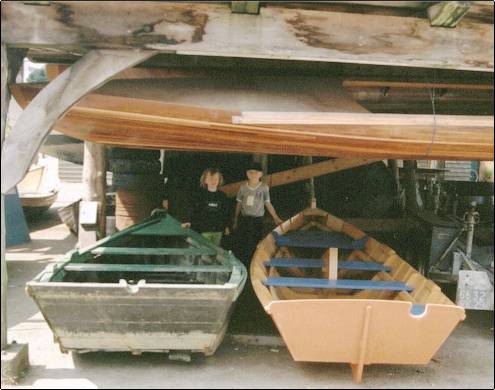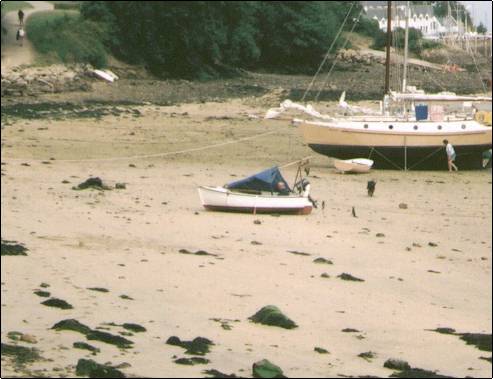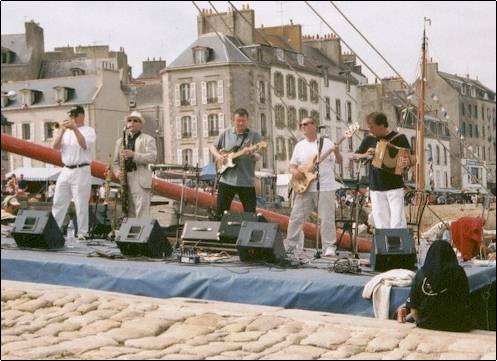 The
kids and I spent a week at this year's Douarnenez Maritime Festival this
summer - I was there to play with my English country dance band, and Ewan
and Ella came along for their first grown-up festival. I have to say that
they behaved extremely well, and seemed to get quite a buzz out of the
experience. The
kids and I spent a week at this year's Douarnenez Maritime Festival this
summer - I was there to play with my English country dance band, and Ewan
and Ella came along for their first grown-up festival. I have to say that
they behaved extremely well, and seemed to get quite a buzz out of the
experience.
 Anyway,
Douarnenez isn't just any old maritime festival - it specialises in old,
classic craft and home-builts, and I thought you might like to see some of
the photos I brought home. The picture above is of the Sedov, a Russian
sail training craft that makes part of its income visiting festivals such
as this. Anyway,
Douarnenez isn't just any old maritime festival - it specialises in old,
classic craft and home-builts, and I thought you might like to see some of
the photos I brought home. The picture above is of the Sedov, a Russian
sail training craft that makes part of its income visiting festivals such
as this.
 They
say there are typically 2000 boats at the Douarnenez festival, and I can
well believe it. Just clock this forest of masts - and this is just one
small corner of it all. They
say there are typically 2000 boats at the Douarnenez festival, and I can
well believe it. Just clock this forest of masts - and this is just one
small corner of it all.
  I
thought I'd start by showing you a vessel that knocked me out as soon as I
saw it. It's what's called a Bisquine, and as you can see it's a most
impressive lug rigged boat. Here you see it strutting its stuff in a light
breeze, accompanied by a small steam launch. I
thought I'd start by showing you a vessel that knocked me out as soon as I
saw it. It's what's called a Bisquine, and as you can see it's a most
impressive lug rigged boat. Here you see it strutting its stuff in a light
breeze, accompanied by a small steam launch.
Next, I thought you might like to see one of the Auray Punts made
famous more than a century ago by Claude Worth. The punt was later
re-worked by Phil Bolger and included in Boats With an Open Mind. Only the
sharp-eyed will see the punt in the first photo, set against a background
of traditional Breton fishing boats




however the subsequent shots clearly show the boat's lines, thole
pins and something of its general construction. I have to say that the
very salty-looking matelot using the little boat could not understand why
I so much wanted to take photos - I can only conclude he hadn't read
either Worth or Bolger.
 There
was so much at Douarnenez that I had not seen before and could not
identify, and some I could. Sadly my photos of currachs have been lost
(the camera wasn't set quite right), but I did get this shot of a (to me)
mysterious skin boat. There
was so much at Douarnenez that I had not seen before and could not
identify, and some I could. Sadly my photos of currachs have been lost
(the camera wasn't set quite right), but I did get this shot of a (to me)
mysterious skin boat.
  It's
interesting that that lightweight Swampscott-style dories and Bolger Light
Dories are very popular in France. I haven't included any photos here, but
I thought these two photos of a small sharpie and a small garvey-like
craft were interesting. I've read that the sharpie type was imported into
France during the late 19th century and became quite popular - perhaps
these two craft represent are the result of that development. It's
interesting that that lightweight Swampscott-style dories and Bolger Light
Dories are very popular in France. I haven't included any photos here, but
I thought these two photos of a small sharpie and a small garvey-like
craft were interesting. I've read that the sharpie type was imported into
France during the late 19th century and became quite popular - perhaps
these two craft represent are the result of that development.
 In
fact, the French have some interesting flat-bottomed boats of their own.
Here's a boat from the Loire valley motoring with an outboard. Notice the
extraordinary rudder arrangement (developed I suggest for areas with many
sandbanks). In
fact, the French have some interesting flat-bottomed boats of their own.
Here's a boat from the Loire valley motoring with an outboard. Notice the
extraordinary rudder arrangement (developed I suggest for areas with many
sandbanks).
Here are three more French flatties I found in Douarnenez's great
little museum. Flattie 1 really does have open grown frames; the sail is a
spritsail; and the green punt is a traditional pleasure boat.



I also saw a number of flat-bottomed skiffs that could have come
straight out of Chappelle - though I'm pretty sure they were native to
Brittany.

At the opposite end of the scale, this little daysailer's lines seem
to me to be typical of the tubby, solidly built craft that have been
traditional along this coast.


I thought some of you might be encouraged by the sight of this happy
camper, again in a boat that seems to me typical of France's west coast.

Now, a couple of classic French boats of more modern times. I think
the first is a Serpentaire, a very popular trailer-sailer, the second is a
16ft pram widely used for teaching sailing, in much the same way that
British sailing schools rely on the Wayfarer. Some may notice that there's
a very similar design by Jacques Mertens-Goosens.


Here's a boat I think was in fact designed by Jacques.

Down on the beach I was also struck by this boat, which seems to me
is the kind of thing a lone skipper would specify for serious blue-water
sailing. Does anybody know anything about this very interesting boat?



Finally, I thought I should include this photo of the band playing
on a floating stage. The main point of interest here is the Duckworks
teeshirt. I think this shot clearly demonstrates the smart appearance and
versatility of the Duckworks tee - it really is perfect for all informal
and many formal situations. Click the picture for more information.
 |